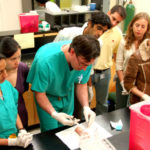Is a 3.7 GPA Good? Colleges that Accept a 3.7 GPA
What’s Covered:
- Is a 3.7 GPA Good?
- How Do Colleges Evaluate GPAs?
- Which Colleges Accept a 3.7 GPA?
- How to Improve Your GPA
- What if You Don’t Have Time to Improve Your GPA?
College applications ask for a lot of information about applicants, and your GPA is definitely one of the more important data points. Each college has an average high school GPA for accepted students that prospective applicants can use as a gauge for whether their grades are high enough to meet the college’s standards.
This post will help you find schools where the average unweighted high school GPA of enrolled students is 3.7.
Not sure what your unweighted GPA is on a 4.0 scale? Use our GPA converter.
Is a 3.7 GPA Good?
The answer to this question is largely a matter of perspective. Generally, a student’s GPA is “good” if it’s competitive at the colleges they hope to attend. If your high school GPA is at or above your desired college’s average, that’s good! If your high school GPA is below the average, you will need to get it higher to have the best chances of admission.
A 3.7 GPA is above the national average for SAT test takers of 3.38, according to a 2016 study, so you should have plenty of college choices.
To see how your GPA stacks up at your dream schools, put your information into our free chancing engine. The engine will take your GPA, as well as your test scores, extracurriculars, and course rigor into account to help you improve your application profile.
How Do Colleges Evaluate GPAs?
Grades are an important component of the admissions process—after all, your GPA is often the first thing an admission committee sees, and it can affect whether or not your application is even read by admissions officers.
Many colleges, particularly prestigious schools, use a screening tool called the Academic Index (AI) to quickly evaluate thousands of applications and screen out academically unqualified applicants. A student’s AI is a calculation that boils their overall academic performance—GPA and test scores—down to a single numerical score, which is compared against a school’s average admissions profile to determine whether their application is read.
That said, college admissions committees know that GPA varies from high school to high school. Because of this variance, before computing a student’s AI, admissions committees will recalculate applicant GPAs using their own grading systems.
Some colleges give more weight to honors and AP classes, while others count only core courses like English, math, science, history, and foreign languages, eliminating electives from GPA. Admissions committees may also take a high school’s difficulty into account. School difficulty refers to things such as a school’s reputation for grade deflation or inflation.
Which Colleges Accept a 3.7 GPA?
Below are the top colleges that have first-year classes with an average high school GPA of 3.7.
It’s worth noting that the schools on this list aren’t the only institutions that students with this grade point average should consider. Many universities neglect to publish average GPAs due to high school variations, so do your research before ruling a school in or out.
|
School Name |
Location |
School Type |
Acceptance Rate |
|
Montevallo, Alabama |
Public |
90% |
|
|
Mobile, Alabama |
Public |
65% |
|
|
Flagstaff, Arizona |
Public |
80% |
|
|
Jonesboro, Arkansas |
Public |
63% |
|
|
Conway, Arkansas |
Public |
92% |
|
|
California State Polytechnic University, Pomona | Cal Poly Pomona |
Pomona, California |
Public |
55% |
|
Long Beach, California |
Public |
40% |
|
|
Orange, California |
Private |
73% |
|
|
San Diego, California |
Private |
82% |
|
|
Santa Clara, California |
Private |
52% |
|
|
Aliso Viejo, California |
Private |
57% |
|
|
Fort Collins, Colorado |
Public |
91% |
|
|
Boulder, Colorado |
Public |
79% |
|
|
New London, Connecticut |
Private |
40% |
|
|
Fairfield, Connecticut |
Private |
52% |
|
|
Tallahassee, Florida |
Public |
33% |
|
|
Deland, Florida |
Private |
94% |
|
|
Coral Gables, Florida |
Private |
19% |
|
|
Honolulu, Hawaii |
Public |
70% |
|
|
West Lafayette, Indiana |
Public |
69% |
|
|
Des Moines, Iowa |
Private |
69% |
|
|
Ames, Iowa |
Public |
90% |
|
|
Lawrence, Kansas |
Public |
88% |
|
|
New Orleans, Louisiana |
Private |
95% |
|
|
Baltimore, Maryland |
Private |
83% |
|
|
Towson, Maryland |
Public |
79% |
|
|
Worcester, Massachusetts |
Private |
50% |
|
|
Lowell, Massachusetts |
Public |
85% |
|
|
Allendale, Michigan |
Public |
92% |
|
|
Saint Peter, Minnesota |
Private |
74% |
|
|
Northfield, Minnesota |
Private |
56% |
|
|
Warrensburg, Missouri |
Public |
71% |
|
|
New Mexico Institute of Mining and Technology | New Mexico Tech |
Socorro, New Mexico |
Public |
97% |
|
Garden City, New York |
Private |
77% |
|
|
New York, New York |
Public |
51% |
|
|
Buffalo, New York |
Private |
78% |
|
|
Buffalo, New York |
Private |
92% |
|
|
New York, New York |
Private |
58% |
|
|
New York, New York |
Public |
46% |
|
|
Rochester, New York |
Private |
67% |
|
|
Syracuse, New York |
Private |
52% |
|
|
The State University of New York at Cortland | SUNY Cortland |
Cortland, New York |
Private |
60% |
|
The State University of New York College of Environmental Science and Forestry | SUNY ESF |
Syracuse, New York |
Public |
65% |
|
The State University of New York Polytechnic Institute | SUNY Poly |
Utica, New York |
Public |
77% |
|
Berea, Ohio |
Private |
77% |
|
|
Oberlin, Ohio |
Private |
34% |
|
|
Westerville, Ohio |
Private |
83% |
|
|
Findlay, Ohio |
Private |
83% |
|
|
Cincinnati, Ohio |
Public |
85% |
|
|
Norman, Oklahoma |
Public |
73% |
|
|
Newberg, Oregon |
Private |
92% |
|
|
Portland, Oregon |
Private |
81% |
|
|
Elizabethtown, Pennsylvania |
Private |
79% |
|
|
Selinsgrove, Pennsylvania |
Private |
77% |
|
|
Greenwood, South Carolina |
Public |
69% |
|
|
Spartanburg, South Carolina |
Private |
52% |
|
|
Laredo, Texas |
Public |
54% |
|
|
San Antonio, Texas |
Private |
34% |
|
|
Fairfax, Virginia |
Public |
90% |
|
|
Winchester, Virginia |
Private |
74% |
|
|
Spokane, Washington |
Private |
70% |
|
|
Walla Walla, Washington |
Private |
48% |
|
|
Washington, D.C. |
Private |
35% |
|
|
Huntington, West Virginia |
Public |
97% |
|
|
Milwaukee, Wisconsin |
Private |
67% |
How to Improve Your GPA
If the colleges that interest you have a higher average high school GPA than 3.7, you may want to consider increasing your GPA. In fact, we recommend trying to get your GPA as high as possible regardless as it will give you more of a competitive edge on your college application.
Here are some ways for you to raise your GPA:
1. Lighten Your Course Load
If you feel like you can master course material just fine but don’t have the time to do so, you could be taking too many time-consuming or advanced classes. Perhaps if you lightened your course load a bit, you would be able to devote the proper amount of time to each course and have more time to study overall. Don’t worry–colleges won’t penalize you a bunch for taking 3 advanced classes instead of 5.
2. Switch Up Your Courses
Perhaps your course load is fine, but you’re just not interested in the classes that you are taking. You should listen to what your grades are telling you. Take classes that you are truly interested in and have a passion for, and you’ll find that good grades come more naturally.
3. Take Something Extracurricular Off Your Plate
Maybe you’re taking all the right classes at the right level of difficulty, but you don’t have time to study due to other commitments. This could be a lot of extracurricular activities, a demanding job, or even family responsibilities that you can’t ignore. If this sounds like you, see if you can lessen the amount of non-academic activities you are pursuing to use that time to focus on studying.
4. Phone a Friend
There are many ways that you can get extra help if you are struggling in a class. You can reach out to your teacher and try to arrange a time for one-on-one help with the material. You can seek out a tutor, preferably someone who took the class recently and with the same instructor. You can look online to see if the topics that you are struggling with have been covered by someone else in a way that makes sense to you.
There are plenty of resources out there that can help you understand the material better. You simply have to commit to seeking them out yourself.
What if You Don’t Have Time to Improve Your GPA?
If you are in your last year of high school or are planning on applying to college without taking any more classes, you should turn your attention to aspects of your application that are still in your control like your essays, test scores, and letters of recommendation.
Because of the importance of the Academic Index, we recommend you focus on performing exceptionally well on your standardized tests to ensure that your application is read by admissions officers.
A 3.7 GPA is above average, so you don’t need to worry too much about improving your GPA—you should still have a good shot at getting into most schools.



